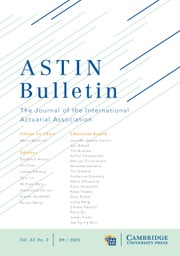No CrossRef data available.
Article contents
A study of one-factor copula models from a tail dependence perspective
Published online by Cambridge University Press: 04 October 2024
Abstract
Modeling multivariate dependence in high dimensions is challenging, with popular solutions constructing multivariate copula as a composition of lower dimensional copulas. Pair-copula constructions do so by using bivariate linking copulas, but their parametrization, in size, being quadratic in the dimension, is not quite parsimonious. Besides, the number of regular vines grows super-exponentially with the dimension. One parsimonious solution is factor copulas, and in particular, the one-factor copula is touted for its simplicity – with the number of parameters linear in the dimension – while being able to cater to asymmetric non-linear dependence in the tails. In this paper, we add nuance to this claim from the point of view of a popular measure of multivariate tail dependence, the tail dependence matrix (TDM). We focus on the one-factor copula model with the linking copula belonging to the BB1 family, pointing out later the applicability of our results to a wider class of linking copulas. For this model, we derive tail dependence coefficients and study their basic properties as functions of the parameters of the linking copulas. Based on this, we study the representativeness of the class of TDMs supported by this model with respect to the class of all possible TDMs. We establish that since the parametrization is linear in the dimension, it is no surprise that the relative volume is zero for dimensions greater than three, and hence, by necessity, we present a novel manner of evaluating the representativeness that has a combinatorial flavor. We formulate the problem of finding the best representative one-factor BB1 model given a target TDM and suggest an implementation along with a simulation study of its performance across dimensions. Finally, we illustrate the results of the paper by modeling rainfall data, which is relevant in the context of weather-related insurance.
- Type
- Research Article
- Information
- Copyright
- © The Author(s), 2024. Published by Cambridge University Press on behalf of The International Actuarial Association


